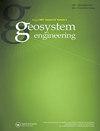Hydrometallurgical recycling of critical metals from spent Ni-Cd batteries with emphasis on the separation of Cd2+ over Ni2+ using D2EHPA
IF 1.1
Q3 GEOSCIENCES, MULTIDISCIPLINARY
引用次数: 3
Abstract
ABSTRACT The present study is comprised of a hydrometallurgical process investigated for the recovery of critical metals viz. nickel (Ni) and cadmium (Cd) from spent Ni-Cd batteries with a focus on solvent extraction of Cd-ions. The leaching performed at 5 (w/v)% pulp density using 2.0 M H2SO4 with 7 (v/v)% H2O2 for 6 h duration at 90°C yielded the maximum leaching efficiency of >91% Ni and >99% Cd along with a significant quantity of Fe (>87%). Iron was subjected to hydrolytic precipitation to its complete removal (below 10 ppm in the solution) from the leach liquor at a pH of ~3.5. After that, the Ni-Cd-containing solution was contacted with di-(2-ethylhexyl) phosphoric acid (D2EHPA) to study the extraction behavior as a function of extractant concentration, equilibrium pH, and organic-to-aqueous (O:A) phase ratio. At an equilibrium pH of 3.3, a significant quantity of Ni (>18%) was co-extracted with ~73% Cd by contacting 20 (v/v)% D2EHPA, which was completely scrubbed by contacting 15 g/L CdSO4 solution at an O:A ratio of 2. The scrubbed organic containing 14.4 g/L Cd was then recovered by stripping with 1.5 M H2SO4 solution at an O:A ratio of 1, yielding >99% Cd into the aqueous phase. Further, Ni was recovered from the raffinate by adding soda ash at Na2CO3:Ni2+ ratio = 2.5, temperature = 50°C, and time = 1 h, which was analyzed to be NiCO3.2Ni(OH)2 with purity >99.9%. The experimental results showed the potential of hydrometallurgical tools for the recovery of critical metals from spent Ni-Cd batteries.废镍镉电池中关键金属的湿法冶金回收,重点是D2EHPA从Ni2+中分离Cd2+
本文章由计算机程序翻译,如有差异,请以英文原文为准。
求助全文
约1分钟内获得全文
求助全文

 求助内容:
求助内容: 应助结果提醒方式:
应助结果提醒方式:


